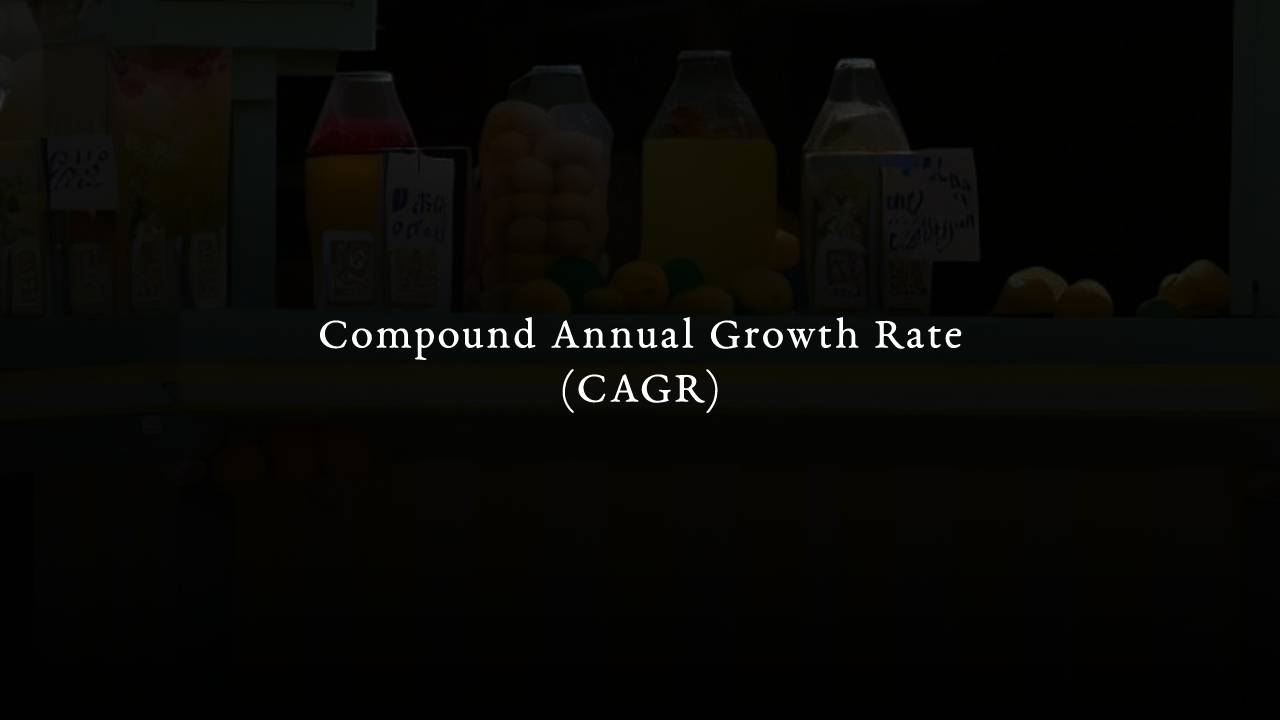Introduction
The Compound Annual Growth Rate (CAGR) is a popular investment metric that calculates the annualized rate of growth of an investment over a specified time period. The article explores the key factors that impact CAGR, including the formula, alternative metrics such as Average Annual Growth Rate (AAGR) and Internal Rate of Return (IRR). Throughout the article, the importance of considering the impact of CAGR when making investment decisions is emphasized, bearing in mind dividends, long-term investing, volatility, and forecasting. Whether you are a novice or experienced investor, this article will provide valuable insights into how CAGR can help you evaluate your investment performance and make informed decisions for your financial future.
Table of Contents
- Introduction
- CAGR explained
- CAGR Forecasting and Comparison
- CAGR Vs AAGR Example
- Compound Annual Growth Rate limitations
- CAGR calculator
- Sustaining CAGR with multiple metrics
- Conclusions
- Bibliography
CAGR explained
C.A.G.R. is an acronym, it stands for:
- Compound: because it takes into account the compounding effect of earnings reinvestment over time;
- Annual: because it uses the annualization conversion, so the result will be expressed into an annual basis;
- Growth Rate: because its goal is to measure how much something has grown or changed over a period of time.
Basically, CAGR is a way to measure how fast something is growing or changing over time (Takahashi, Yamada, 2014).
To calculate CAGR, you need to know the starting value and ending value of what you’re measuring, and how long it took to grow or change. Then, you can figure out the annualized rate of growth that would have resulted in that change over that time period.
For example, let's say you have a lemonade stand and you made $100 in your first year, $120 in your second year, and $150 in your third year. To calculate the CAGR, you would first figure out the total growth over the three years, which is $50. Then, you would figure out how many years it took to grow, which is 3. Finally, you would figure out the average growth rate per year that would have resulted in that change, which is about 14.5%.
CAGR Forecasting, Interpretation and Comparison
Compound Annual Growth Rate (CAGR) can be used to forecast the future returns of an investment. But, and this is a big but, it’s based on the assumption that the investment will maintain the same growth rate over the entire forecast period. Also, it’s important to note that past performance is not indicative of future results. When forecasting, it’s fundamental to consider market conditions and other external factors that may impact the performance of the investment.
What is considered a good CAGR?
It depends. Generally speaking, a CAGR of 10% or higher is often considered a good return for long-term investments in the stock market, as it can outperform the average historical return of the S&P 500. However, it’s important to keep in mind that investments come with varying degrees of risk and to consider the time horizon of the investment.
About comparison, CAGR allows you to compare different investments or KPIs, giving you a better idea of which investment is better suited for your needs. However, the timeframe must be the same and it’s often recommended to perform the comparison between similar financial measures (e.g. same industry).
CAGR Vs AAGR Example
Average Annual Growth Rate (AAGR) is a simple average of the annual growth rates of an investment. AAGR is calculated by taking the difference between the ending and beginning values, dividing that by the number of years, and then dividing that by the beginning value. AAGR is not as accurate as CAGR because it does not take into account the compounding effect of the returns.
AAGR is best used for short-term investments, since it simply divides the total growth rate by the number of years.
Below, there’s an example of a 10-year investment to compare the AAGR and CAGR.
Let’s say you invest $10,000 in a mutual fund on January 1, 2013, and the value of the investment grows to $45,000 on December 31, 2023.
| Year | Investment Value | AAGR | CAGR |
|---|---|---|---|
| 1 | $10,000 | – | |
| 2 | $11,000 | 10% | |
| 3 | $20,000 | 82% | |
| 4 | $21,000 | 5% | |
| 5 | $21,500 | 2% | |
| 6 | $27,000 | 26% | |
| 7 | $31,000 | 15% | |
| 8 | $42,000 | 35% | |
| 9 | $44,000 | 5% | |
| 10 | $45,000 | 2% | |
| 18.21% | 16.23% |
Average Annual Growth Rate (AAGR)
To calculate the AAGR, you would take the total return of the investment and divide it by the number of years:
- The growth rates for each of the 10 years are: (10% + 82% + 5% + 2% + 26% + 15% + 35% + 5% + 2%) = 182,11%
- Number of years = 10
AAGR = Growth Rates sum / Number of years = 182,11% / 10 = 18,2% per year
So the AAGR for this investment is, on average, 18% per year over the 10-year period.
Compound Annual Growth Rate (CAGR)
The following formula is used to calculate the CAGR:
CAGR = (Ending value / Beginning value) ^ (1 / Number of years) – 1
CAGR = ($45,000 / $10,000) ^ (1 / 10) – 1
CAGR = 1.1623 – 1
CAGR = 0.1623 or 16.23%
So the CAGR for this investment is 16.23% over the 10-year period.
This example shows that the AAGR and CAGR can be significantly different. The AAGR only takes into account the total return over the entire period, while the CAGR considers the impact of compounding over the same period.
Compound Annual Growth Rate limitations
CAGR is not a perfect metric, and it does have its limitations. One limitation of CAGR is that it assumes that the investment has been held for the entire period. This assumption can be problematic if the investment has been bought or sold during the period, as it can distort the true growth rate.
Another limitation is that CAGR does not account for the volatility of an investment (Welch, 2000). For instance, an investment with a high CAGR may have been volatile, which can be unsettling for some investors. In such cases, other metrics such as IRR or ROI may be more appropriate.
Furthermore, CAGR does not take into account the impact of taxes, which can significantly affect investment returns, especially for long-term investments (Lipuma & Weber, 1983).
Think about Dividends. Dividends are a portion of a company’s profits paid out to shareholders. Dividends can have a significant impact on the CAGR of an investment. If dividends are reinvested, they can increase the returns and thus increase the CAGR.
However, If you’re going to invest in Dividend Growth Market Leaders for one or two year, CAGR might not give you an accurate picture of your investment’s forecasting (Hirst & McEwan, 2004).
CAGR calculator
Are you curious about how fast your investment is growing over time? Do you want to know what the Compound Annual Growth Rate (CAGR) of your investment is, but don’t know how to calculate it? Look no further, because we have a free CAGR online calculator that can help you easily calculate the growth rate of your investment.
Please Note: Keep in mind that the Compound Annual Growth Rate (CAGR) above measures how the value of your investment has changed over a specific time period, assuming all earnings have been reinvested and no deductions have been made. Moreover, if the investment period you entered is too short, CAGR may not accurately represent the actual growth of the investment.
Holistic approach
Sustaining CAGR with multiple metrics
CAGR can and should be used alongside other metrics.
If you’re using Compound Annual Growth Rate for management or entrepreneurship, it’s a good idea to consider other performance metrics alongside CAGR, such as profit margins and cash flow.
While other metrics that are used to measure the growth of an investment include:
- Average Annual Growth Rate (AAGR)
- Internal Rate of Return (IRR)
- Return on Investment (ROI)
- Total Return
- Sortino Ratio
- Treynor Ratio
- Sharpe Ratio
There are several alternatives to CAGR that can provide a more complete picture of an investment’s performance. One such metric is the Total Return, which includes both capital gains and dividends. Another metric is the Sharpe Ratio (Sharpe, 1963), which measures the risk-adjusted return of an investment.
Other metrics include the Sortino Ratio, which measures the downside risk of an investment, and the Treynor Ratio, which measures the excess return of an investment over the risk-free rate, adjusted for its beta.
It is essential to consider the purpose of the calculation and the context in which it is being used when choosing an appropriate metric.
Conclusions
In conclusion, CAGR is an essential metric for measuring investment growth, especially for long-term investments. It provides an accurate measure of investment growth that takes into account the effect of compounding. It is crucial to consider the purpose of the calculation and the context in which it is being used when choosing an appropriate metric. Additionally, investors should take into account the impact of taxes, volatility, and other factors when making investment decisions. By understanding the limitations and trade-offs involved in calculating CAGR and other metrics, investors can make more informed investment decisions and achieve their financial goals.
Bibliography
HIRST, T., & McEWAN, J. (2004). Stock selection based on identifying changes in long-term growth rates. Journal of Investing, 13(1), 48-59.
LIPUMA, J. A., & WEBER, J. (1983). A better way to calculate returns. Financial Analysts Journal, 39(5), 77-81.
SHARPE, W. F. (1963). A simplified model for portfolio analysis. Management Science, 9(2), 277-293.
TAKAHASHI, Y., & YAMADA, K. (2014). Compound annual growth rate for production functions with environmental variables. Environmental Modelling & Software, 52, 216-226.
WELCH, I. (2000). Herding among security analysts. Journal of Financial Economics, 58(3), 369-396.

